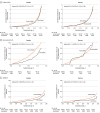Association of SARS-CoV-2 Vaccination During Pregnancy With Pregnancy Outcomes
- PMID: 35323851
- PMCID: PMC8949721
- DOI: 10.1001/jama.2022.3271
Association of SARS-CoV-2 Vaccination During Pregnancy With Pregnancy Outcomes
Abstract
Importance: Data about the safety of vaccines against SARS-CoV-2 during pregnancy are limited.
Objective: To examine the risk of adverse pregnancy outcomes after vaccination against SARS-CoV-2 during pregnancy.
Design, setting, and participants: This registry-based retrospective cohort study included 157 521 singleton pregnancies ending after 22 gestational weeks from January 1, 2021, until January 12, 2022 (Sweden), or January 15, 2022 (Norway). The Pregnancy Register in Sweden and the Medical Birth Registry of Norway were linked to vaccination and other registries for identification of exposure and background characteristics.
Exposures: Data on mRNA vaccines-BNT162b2 (Pfizer-BioNTech) and mRNA-1273 (Moderna)-and 1 viral vector vaccine-AZD1222 (AstraZeneca)-were collected from national vaccination registries.
Main outcomes and measures: The risk of preterm birth and stillbirth was evaluated using Cox regression models, with gestational day as the time metric and vaccination as a time-dependent exposure variable. The risk of small for gestational age, low Apgar score, and neonatal care admission was evaluated using logistic regression. Random-effects meta-analysis was used to combine results between countries.
Results: Among the 157 521 singleton births included in the study (103 409 in Sweden and 54 112 in Norway), the mean maternal age at the time of delivery was 31 years, and 28 506 (18%) were vaccinated against SARS-CoV-2 (12.9% with BNT162b2, 4.8% with mRNA-1273, and 0.3% with AZD1222) while pregnant. A total of 0.7%, 8.3%, and 9.1% of individuals delivering were vaccinated during the first, second, and third trimester, respectively. Vaccination against SARS-CoV-2 was not significantly associated with increased risk of preterm birth (6.2 vs 4.9 per 10 000 pregnancy days; adjusted hazard ratio [aHR], 0.98 [95% CI, 0.91 to 1.05]; I2 = 0%; P for heterogeneity = .60), stillbirth (2.1 vs 2.4 per 100 000 pregnancy days; aHR, 0.86 [95% CI, 0.63 to 1.17]), small for gestational age (7.8% vs 8.5%; difference, -0.6% [95% CI, -1.3% to 0.2%]; adjusted OR [aOR], 0.97 [95% CI, 0.90 to 1.04]), low Apgar score (1.5% vs 1.6%; difference, -0.05% [95% CI, -0.3% to 0.1%]; aOR, 0.97 [95% CI, 0.87 to 1.08]), or neonatal care admission (8.5% vs 8.5%; difference, 0.003% [95% CI, -0.9% to 0.9%]; aOR, 0.97 [95% CI, 0.86 to 1.10]).
Conclusions and relevance: In this population-based study conducted in Sweden and Norway, vaccination against SARS-CoV-2 during pregnancy, compared with no SARS-CoV-2 vaccination during pregnancy, was not significantly associated with an increased risk of adverse pregnancy outcomes. The majority of the vaccinations were with mRNA vaccines during the second and third trimesters of pregnancy, which should be considered in interpreting the findings.
Conflict of interest statement
Figures



Comment in
-
COVID-19 mRNA Vaccines During Pregnancy: New Evidence to Help Address Vaccine Hesitancy.JAMA. 2022 Apr 19;327(15):1451-1453. doi: 10.1001/jama.2022.2459. JAMA. 2022. PMID: 35325030 No abstract available.
References
-
- American College of Obstetricians and Gynecologists . COVID-19 vaccination considerations for obstetric–gynecologic care. Accessed January 18, 2020. https://www.acog.org/clinical/clinical-guidance/practice-advisory/articl...
-
- Centers for Disease Control and Prevention . Information about COVID-19 vaccines for people who are pregnant or breastfeeding. Accessed May 11, 2021. https://www.cdc.gov/coronavirus/2019-ncov/vaccines/recommendations/pregn...
Publication types
MeSH terms
Substances
LinkOut - more resources
Full Text Sources
Medical
Miscellaneous

